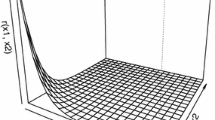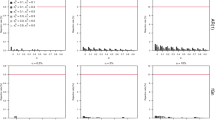Abstract
We present a novel methodology to compute conditional risk measures when the conditioning event depends on a number of random variables. Specifically, given a random vector \((\mathbf {X},Y)\), we consider risk measures that express the risk of Y given that \(\mathbf {X}\) assumes values in an extreme multidimensional region. In particular, the considered risky regions are related to the AND, OR, Kendall and Survival Kendall hazard scenarios that are commonly used in environmental literature. Several closed formulas are considered (especially in the AND and OR scenarios). An application to spatial risk analysis involving real data is discussed.

Similar content being viewed by others
References
Adrian T, Brunnermeier M (2016) CoVaR. Am Econ Rev 106(7):1705–1741
AghaKouchak A (2014) Entropy-copula in hydrology and climatology. J Hydrometeorol 15(6):2176–2189
AghaKouchak A, Easterling D, Hsu K, Schubert S, Sorooshian S (eds) (2013) Extremes in a changing climate. Springer, Netherlands
Azzalini A (2015) The R package sn: the skew-normal and Skew-\(t\) distributions (version 1.3-0). Università di Padova, Italia, http://azzalini.stat.unipd.it/SN
Azzalini A, Capitanio A (2003) Distributions generated by perturbation of symmetry with emphasis on a multivariate skew \(t\)-distribution. J R Stat Soc Ser B Stat Methodol 65(2):367–389
Bender J, Wahl T, Mudersbach C, Jensen J (2013) Flood frequency analysis and river confluences–univariate vs. multivariate extreme value statistics. In: ICWRER 2013 proceedings, vol 1056, pp 216–328
Bernard C, Czado C (2015) Conditional quantiles and tail dependence. J Multivar Anal 138:104–126
Bernardi M, Gayraud G, Petrella L (2015) Bayesian tail risk interdependence using quantile regression. Bayesian Anal 10(3):553–603
Bernardi M, Durante F, Jaworski P (2017) CoVaR of families of copulas. Stat Probab Lett 120:8–17
Brechmann E (2014) Hierarchical Kendall copulas: properties and inference. Can J Stat 42(1):78–108
Cook R, Johnson M (1981) A family of distributions for modelling nonelliptically symmetric multivariate data. J R Stat Soc Ser B 43(2):210–218
Cook RD, Johnson ME (1986) Generalized Burr-Pareto-logistic distributions with applications to a uranium exploration data set. Technometrics 28(2):123–131. doi:10.2307/1270448
Côté MP, Genest C (2015) A copula-based risk aggregation model. Can J Stat 43(1):60–81
Cousin A, Di Bernardino E (2013) On multivariate extensions of value-at-risk. J Multivar Anal 119:32–46
De Michele C, Salvadori G, Passoni G, Vezzoli R (2007) A multivariate model of sea storms using copulas. Coast Eng 54:734–751. doi:10.1016/j.coastaleng.2007.05.007
Di Bernardino E, Palacios-Rodríguez F (2016) Estimation of extreme quantiles conditioning on multivariate critical layers. Environmetrics 27(3):158–168
Di Bernardino E, Fernández-Ponce JM, Palacios-Rodríguez F, Rodríguez-Griñolo MR (2015) On multivariate extensions of the conditional value-at-risk measure. Insur Math Econ 61:1–16
Durante F, Salvadori G (2010) On the construction of multivariate extreme value models via copulas. Environmetrics 21(2):143–161. doi:10.1002/env.988
Durante F, Sempi C (2016) Principles of copula theory. CRC, Boca Raton
Favre AC, El Adlouni S, Perreault L, Thiémonge N, Bobée B (2004) Multivariate hydrological frequency analysis using copulas. Water Resour Res 40(1):W01,101. doi:10.1029/2003WR002456
Field C, Barros V, Stocker T, Dahe Q (eds) (2012) Managing the risks of extreme events and disasters to advance climate change adaptation, mathematics and its applications, vol 67. Cambridge University Press, Cambridge, UK, special Report of the Intergovernmental Panel on Climate Change
Föllmer H, Schied A (2011) Stochastic finance. Walter de Gruyter & Co., Berlin
Genest C, Rivest LP (2001) On the multivariate probability integral transformation. Stat Probab Lett 53(4):391–399
Genest C, Rémillard B, Beaudoin D (2009) Goodness-of-fit tests for copulas: a review and a power study. Insur Math Econ 44(2):199–213
Girardi G, Ergün A (2013) Systemic risk measurement: multivariate GARCH estimation of CoVaR. J Bank Financ 37(8):3169–3180
Gräler B, van den Berg MJ, Vandenberghe S, Petroselli A, Grimaldi S, De Baets B, Verhoest NEC (2013) Multivariate return periods in hydrology: a critical and practical review focusing on synthetic design hydrograph estimation. Hydrol Earth Syst Sci 17(4):1281–1296. doi:10.5194/hess-17-1281-2013
Hakwa B, Jäger-Ambrozewicz M, Rüdiger B (2015) Analysing systemic risk contribution using a closed formula for conditional value at risk through copula. Commun Stoch Anal 9(1):131–158
Hamel AH, Heyde F (2010) Duality for set-valued measures of risk. SIAM J Financ Math 1(1):66–95
Hering C, Hofert M, Mai JF, Scherer M (2010) Constructing hierarchical Archimedean copulas with Lévy subordinators. J Multivar Anal 101(6):1428–1433
Hofert M, Kojadinovic I, Maechler M, Yan J (2015) copula: multivariate dependence with copulas. http://CRAN.R-project.org/package=copula, r package version 0.999-14
Jaworski P (2017) On conditional value at risk (CoVaR) for tail-dependent copulas. Depend Model 5(1):1–19
Joe H (2015) Dependence modeling with copulas. CRC, London
Joe H, Sang P (2016) Multivariate models for dependent clusters of variables with conditional independence given aggregation variables. Comput Stat Data Anal 97:114–132
Jorion P (2006) Value at risk: the new benchmark for managing financial risk. McGraw-Hill, New York
Kojadinovic I, Yan J (2011) A goodness-of-fit test for multivariate multiparameter copulas based on multiplier central limit theorems. Stat Comput 21(1):17–30. doi:10.1007/s11222-009-9142-y
Mainik G, Schaanning E (2014) On dependence consistency of CoVaR and some other systemic risk measures. Stat Risk Model 31(1):49–77
Nappo G, Spizzichino F (2009) Kendall distributions and level sets in bivariate exchangeable survival models. Inf Sci 179(17):2878–2890
Okhrin O, Okhrin Y, Schmid W (2013) On the structure and estimation of hierarchical Archimedean copulas. J Econom 173(2):189–204
Pfaff B, McNeil A (2012) evir: extreme values in R. https://CRAN.R-project.org/package=evir, r package version 1.7-3
Prékopa A (2012) Multivariate value at risk and related topics. Ann Oper Res 193:49–69
Read LK, Vogel RM (2015) Reliability, return periods, and risk under nonstationarity. Water Resour Res 51(8):6381–6398
Salvadori G (2004) Bivariate return periods via 2-copulas. Stat Methodol 1(1–2):129–144
Salvadori G, De Michele C (2004a) Analytical calculation of storm volume statistics with Pareto-like intensity-duration marginals. Geophys Res Lett 31(GL018):767. doi:10.1029/2003GL018767
Salvadori G, De Michele C (2004b) Frequency analysis via copulas: theoretical aspects and applications to hydrological events. Water Resour Res 40(W12):511. doi:10.1029/2004WR003133
Salvadori G, De Michele C (2006) Statistical characterization of temporal structure of storms. Adv Water Resour 29(6):827–842
Salvadori G, De Michele C, Kottegoda NT, Rosso R (2007) Extremes in nature. An approach using copulas, Water Science and Technology Library, vol 56. Springer, Dordrecht
Salvadori G, De Michele C, Durante F (2011) On the return period and design in a multivariate framework. Hydrol Earth Syst Sci 15:3293–3305
Salvadori G, Tomasicchio GR, D’Alessandro F (2014) Practical guidelines for multivariate analysis and design in coastal and off-shore engineering. Coast Eng 88:1–14. doi:10.1016/j.coastaleng.2014.01.011
Salvadori G, Durante F, Tomasicchio GR, D’Alessandro F (2015) Practical guidelines for the multivariate assessment of the structural risk in coastal and off-shore engineering. Coast Eng 95:77–83. doi:10.1016/j.coastaleng.2014.09.007
Salvadori G, Durante F, De Michele C, Bernardi M, Petrella L (2016) A multivariate copula-based framework for dealing with hazard scenarios and failure probabilities. Water Resour Res 52(5):3701–3721
Serinaldi F (2015) Dismissing return periods!. Stoch Environ Res Risk Assess 29(4):1179–1189
Shiau TJ (2003) Return period of bivariate distributed extreme hydrological events. Stoch Environ Res Risk Assess 17(1):42–57
Sordo MA, Suárez-Llorens A, Bello AJ (2015) Comparison of conditional distributions in portfolios of dependent risks. Insur Math Econ 61:62–69
Wang C, Chang NB, Yeh GT (2009) Copula-based flood frequency (COFF) analysis at the confluences of river systems. Hydrol Process 23(10):1471–1486
Acknowledgements
We would like to thanks the Reviewers for helpful comments and careful reading. Helpful discussions with C. Sempi (Università del Salento, Lecce, Italy) are also gratefully acknowledged. [FD] This work was partially supported by the Faculty of Economics and Management, Free University of Bozen-Bolzano, via the project “NEW-DEMO”. Moreover, the work has been also partially supported by INdAM-GNAMPA Project 2017 “Bounds for Risk Functionals in Dependence Models”. [PJ] The support from National Science Centre, Poland, under project 2015/17/B/HS4/00911 is acknowledged. [GS] The support of the CMCC (Centro Euro-Mediterraneo sui Cambiamenti Climatici, Lecce (Italy)) is acknowledged.
Author information
Authors and Affiliations
Corresponding author
Rights and permissions
About this article
Cite this article
Bernardi, M., Durante, F., Jaworski, P. et al. Conditional risk based on multivariate hazard scenarios. Stoch Environ Res Risk Assess 32, 203–211 (2018). https://doi.org/10.1007/s00477-017-1425-9
Published:
Issue Date:
DOI: https://doi.org/10.1007/s00477-017-1425-9




